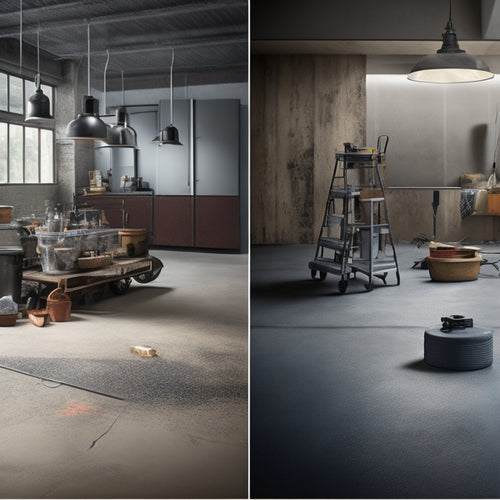
Renting the Right Tools for Concrete Removal
Share
When it comes to concrete removal, having the right tools is vital for efficiency and effectiveness. You'll want to take into account the type of concrete, project scope, and intended use to select the best tools for the job. Demolition hammers, saw cutting equipment, and drill bits are essential tools, each with its own strengths and ideal applications. Renting these tools can be a cost-effective solution, especially for one-time or infrequent projects. By understanding your options and selecting the right tools, you'll be able to tackle your concrete removal project with confidence - and as you explore further, you'll discover the specific tools and techniques that will take your project to the next level.
Key Takeaways
• Understanding the type of concrete and project scope helps in selecting the right tools for efficient concrete removal.
• Demolition hammers, saw cutting equipment, and drill bits are essential tools for concrete removal, each with specific uses and features.
• Renting tools offers cost savings, flexibility, and access to specialized gear, ideal for one-time or infrequent projects.
• Choosing the right removal method and tool depends on project size, concrete type, and condition, as well as environmental and safety concerns.
• Regular maintenance of rented tools is crucial for peak performance, longevity, and safety, and should be performed according to manufacturer's guidelines.
Understanding Concrete Block Uses
When building or renovating structures, you often encounter concrete blocks, which serve as a fundamental component in various construction projects, providing strength, durability, and versatility. These blocks are widely used in concrete block applications, such as foundation walls, retaining walls, and building facades. You'll also find them in block construction techniques like partition walls, boundary walls, and decorative features.
Concrete blocks offer numerous benefits, including resistance to natural disasters, fire, and pests. They're also cost-effective, low maintenance, and can be used in a variety of architectural styles.
When working with concrete blocks, it's important to understand the different block construction techniques, such as laying, bonding, and finishing. You'll need to take into account factors like block size, shape, and texture to guarantee a sturdy and aesthetically pleasing structure.
As you explore concrete removal projects, understanding concrete block uses and applications will help you navigate the process more effectively. By recognizing the role concrete blocks play in construction, you'll be better equipped to tackle removal tasks with confidence and precision.
Types of Concrete Removal Tools
When renting tools for concrete removal, you'll need to contemplate the right equipment for the job.
You'll have to choose from a range of options, including demolition hammers, saw cutting equipment, and drill bits, each designed for specific tasks and concrete types.
Demolition Hammer Options
By evaluating your project's specific needs, you'll find that demolition hammers come in various types, each suited for distinct concrete removal tasks and offering unique benefits.
For instance, electric demolition hammers are ideal for small to medium-sized projects, providing a high power-to-weight ratio and reduced fatigue. Pneumatic demolition hammers, on the other hand, are better suited for larger projects, offering increased force and productivity. You'll also find hydraulic demolition hammers, which excel in heavy-duty applications and provide maximum force.
When selecting a demolition hammer, it's important to take into account factors such as weight, handle type, and vibration reduction features to guarantee peak performance and operator comfort.
Additionally, proper equipment maintenance is vital to extend the lifespan of your demolition hammer and prevent downtime. Regularly inspect and maintain your equipment to make sure it's functioning at its best.
Saw Cutting Equipment
Saw cutting equipment, a staple in concrete removal, empowers you to make precise cuts in concrete surfaces, allowing for controlled demolition and minimizing collateral damage.
You'll need to choose the right saw blade type for your project, as they vary in diamond grit, segment style, and bond type. A diamond blade with a high grit count is ideal for cutting through hard, abrasive concrete, while a blade with a lower grit count is better suited for softer concrete.
When it comes to saw cutting techniques, you'll want to master the push-stroke method, where you apply gentle pressure and make slow, consistent passes. This technique helps maintain control and prevents the saw from binding or kicking back.
Additionally, you can use the plunge-cut method for making deeper cuts or the walk-behind saw for larger projects. Regardless of the technique, it's crucial to maintain a steady pace and keep the saw blade clean and well-lubricated to guarantee a smooth cut.
Drill Bit Selection
You'll need to select the right drill bit for your concrete removal project, as the type and quality of the bit can greatly impact the efficiency and effectiveness of the demolition process.
When it comes to drilling through concrete, you'll want to opt for a masonry drill bit designed specifically for this purpose. These bits are typically made with tungsten carbide tips, which provide the necessary strength and durability to penetrate through concrete.
For more aggressive drilling, consider using diamond bits, which feature a diamond-coated cutting edge. Diamond bits are ideal for drilling through heavily reinforced concrete or when speed is a priority. They're also available in various sizes and shapes to accommodate different drilling applications.
When choosing a drill bit, consider the type of concrete you're working with, as well as the intended use of the drill bit. Look for bits that are designed for high-torque applications and feature a durable construction to withstand the rigors of concrete drilling.
Picking the Right Removal Method
When tackling a concrete removal project, determining the most suitable removal method is crucial, as it directly affects the project's efficiency, cost, and overall success. You need to contemplate the type and size of the concrete, the level of reinforcement, and the desired outcome.
Manual removal methods, such as hammering and chiseling, can be effective for small-scale projects, but they can be labor-intensive and time-consuming.
To make an informed decision, reflect on the following factors:
-
Project scope and size: Larger projects may require more heavy-duty equipment, while smaller projects can be handled with manual removal methods.
-
Concrete type and condition: Reinforced concrete may require more advanced removal methods, such as hydraulic demolition or saw cutting.
-
Cost considerations: Different removal methods vary greatly in cost, so it's vital to balance your budget with the project's requirements.
- Environmental and safety concerns: Some removal methods may generate excessive noise, dust, or vibrations, which need to be mitigated to guarantee a safe working environment.
Benefits of Tool Rental Services
Having determined the most suitable removal method, you can now focus on acquiring the necessary equipment. Renting tools for concrete removal can be a cost-effective and efficient solution.
By opting for tool rental services, you can experience significant cost savings compared to purchasing the equipment outright. This approach is particularly beneficial for one-time or infrequent projects, where the tools may not be needed again in the near future.
Renting tools also offers project flexibility, allowing you to adapt to changing project requirements or unexpected setbacks. If you encounter unexpected obstacles or need to adjust your removal strategy, you can quickly swap out tools or add new ones to your arsenal without being tied to a specific equipment purchase.
Additionally, many rental services offer a wide range of tools and equipment, giving you access to specialized gear that might be outside your budget to purchase. By leveraging tool rental services, you can stay focused on the project at hand, while leaving the equipment logistics to the experts.
Concrete Block Removal Tool Options
Concrete block removal typically requires a combination of brute force and precision, making a hydraulic breaker or a concrete crusher an ideal tool for demolishing and dislodging blocks. These tools provide the necessary power to break apart concrete blocks, allowing you to efficiently remove them from your work site.
When choosing a concrete block removal tool, take into account the following options:
-
Hydraulic Breaker: A hydraulic breaker is a versatile tool that can be used for a variety of concrete removal tasks, from breaking up small blocks to demolishing large slabs.
-
Concrete Crusher: A concrete crusher is a specialized tool designed specifically for crushing and pulverizing concrete blocks, making it an ideal choice for large-scale block disposal projects.
-
Pneumatic Breaker: A pneumatic breaker is a cost-effective option for smaller concrete removal projects, providing a reliable and efficient way to break apart blocks.
- Demolition Robot: A demolition robot is a high-tech tool that can be used for precision demolition and removal of concrete blocks, offering a safe and efficient solution for complex projects.
When comparing rental costs, be sure to take into account the specific needs of your project, including block disposal methods and the scale of the removal task.
Electric Vs Hydraulic Breakers
You'll likely need to decide between electric and hydraulic breakers for your concrete removal project, as both options offer unique advantages and considerations.
Electric breakers are a popular choice due to their lower upfront costs and ease of maintenance. They're also relatively quiet and produce minimal vibrations, making them suitable for indoor or residential projects. Additionally, electric breaker advantages include reduced noise pollution and increased precision, allowing for more controlled demolition.
On the other hand, hydraulic breakers are renowned for their sheer power and hydraulic breaker efficiency, making them ideal for large-scale or heavy-duty projects. They're capable of delivering high impact forces, making quick work of thick concrete slabs. However, hydraulic breakers typically require more maintenance and are often heavier and more expensive than their electric counterparts.
Consider the scope and requirements of your project to determine which type of breaker best suits your needs. By weighing the pros and cons of each, you can make an informed decision and guarantee a successful concrete removal project.
Safety Features to Consider
Before operating a breaker, confirm you're properly equipped with safety gear, including hard hats, safety glasses, and dust masks, as the demolition process can generate hazardous debris and airborne particles. Your personal protective equipment (PPE) is essential to preventing injuries and guaranteeing a safe working environment.
When it comes to equipment maintenance, you should:
-
Regularly inspect your breaker and accessories for signs of wear or damage.
-
Follow the manufacturer's guidelines for equipment maintenance and repair.
-
Perform routine checks on your PPE to verify it's in good condition.
- Store equipment properly when not in use to prevent damage or misuse.
Renting Tools for Efficient Demolition
To streamline your concrete removal process, consider renting specialized tools designed to tackle specific tasks, such as hydraulic breakers, floor saws, or demolition robots.
By choosing the right tool for the job, you'll optimize your demolition techniques and get the project done efficiently. For instance, hydraulic breakers are ideal for breaking up thick concrete slabs, while floor saws are perfect for making precise cuts. Demolition robots, on the other hand, can navigate tight spaces and perform complex tasks with ease.
When selecting a tool rental service, look for providers that offer a range of equipment options and expert guidance on how to use them effectively. This will guarantee you're getting the most out of your tool rental and achieving the desired results.
Additionally, consider the condition and maintenance of the equipment, as well as any safety features and operator training provided. By renting the right tools and following best practices, you'll be able to execute your concrete removal project with precision and confidence.
Frequently Asked Questions
Can I Rent Tools for a Single-Day Concrete Removal Project?
You're wondering if you can rent tools for a single-day concrete removal project.
The answer is yes, many equipment rental companies offer single-day rentals for concrete removal tools. You can rent a breaker, demo saw, or other specialized equipment for a 24-hour period, which is ideal for small to medium-sized projects.
This option saves you money and storage space, while still getting the job done efficiently.
How Do I Transport Heavy Concrete Removal Equipment Safely?
When transporting heavy concrete removal equipment, you'll need to prioritize equipment safety.
Make certain you're familiar with the transport methods recommended by the manufacturer. Use a sturdy trailer or truck with adequate tie-downs to secure the equipment.
Always maintain a safe speed and avoid sudden stops. Consider enlisting a spotter to guide you, especially when maneuvering tight spaces.
Are Tool Rental Services Available on Weekends and Holidays?
As you navigate the labyrinth of tool rental services, you're likely wondering if they'll be there for you when the clock strikes Saturday morning or on a holiday Monday.
The good news is that many top-tier tool rental services offer weekend availability, with some even providing 24/7 emergency support.
Be sure to check their holiday hours in advance, so you can plan your concrete removal project with precision and confidence.
Can I Rent a Tool Operator Along With the Concrete Removal Equipment?
When you're planning a concrete removal project, you're likely wondering if you can rent a tool operator along with the equipment.
The answer is yes, many equipment rental services offer tool operator services as part of their rental packages.
This can be especially helpful if you're short on experienced labor or need expertise with specific equipment.
Be sure to explore these equipment rental options to find a provider that offers operator services to guarantee your project runs smoothly and efficiently.
What Happens if the Rented Tool Breaks Down During the Project?
If your rented tool breaks down during the project, don't panic.
First, contact the rental company to report the issue. They'll send a replacement or repair the tool ASAP.
Make sure you've invested in rental insurance to cover unexpected downtime.
Regular equipment maintenance is also essential to prevent breakdowns.
Inspect tools before use, and follow the manufacturer's guidelines to minimize the risk of equipment failure.
Conclusion
As you wrap up your concrete removal project, remember that having the right tools is like having the right map for a road trip - it gets you to your destination efficiently and safely.
Without it, you're stuck in traffic, wasting time and resources.
With tool rental services, you can navigate even the toughest concrete removal projects with ease, and get back to building something new in no time.
Related Posts
-

5 Tools Needed for Quick Fix Concrete Mixing
You'll need five essential tools to tackle a quick fix concrete mixing project efficiently. First, you'll require a s...
-

Top Tools for Revamping Old Concrete Floors
You'll need a range of tools to revamp your old concrete floor, starting with epoxy, acrylic, or polyurethane paint, ...
-

What Tools Are Needed for Concrete Wall Foundations
You'll need a thorough array of tools and equipment to construct a concrete wall foundation that meets structural int...


